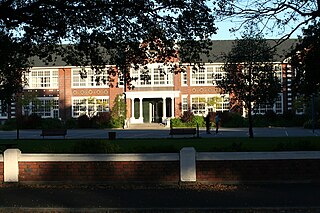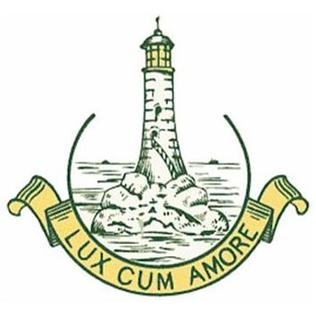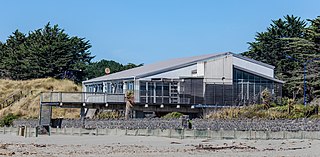
Canterbury is a region of New Zealand, located in the central-eastern South Island. The region covers an area of 44,503.88 square kilometres (17,183.04 sq mi), making it the largest region in the country by area. It is home to a population of 694,400.

Cashmere High School is a state coeducational secondary school, located in southern Christchurch, New Zealand. It was opened in 1956 in response to population growth in southern Christchurch during the 1950s.

Rolleston is the seat and largest town in the Selwyn District, in the Canterbury region of New Zealand's South Island. It is located on the Canterbury Plains 22 kilometres (14 mi) south-west of Christchurch, and is part of the wider Christchurch metropolitan area.

Massey High School is a co-educational state secondary school in West Auckland, New Zealand established in 1969. The school is located on the western edge of the city, thus obtaining students from both suburban and rural backgrounds. In 2017 it was rated decile 4.

St. Bede's College is an integrated Roman Catholic day and boarding school in Christchurch, New Zealand, for boys aged 12 to 18. St. Bede's is the oldest Roman Catholic Boys' College in New Zealand's South Island. It is also the only Catholic day and boarding college for boys in New Zealand's South Island. Students at St Bede's are colloquially known as Bedeans. St Bede's College was founded in 1911 by the Marists, a religious congregation founded in Lyon, France, in 1816.

Christchurch Girls' High School in Christchurch, New Zealand, was established in 1877 and is the second oldest girls-only secondary school in the country, after Otago Girls' High School.

Queen Elizabeth II Stadium was a multi-use stadium in Christchurch, New Zealand, located in a large park called Queen Elizabeth II Park. The stadium had a capacity of 25,000 people and was built in 1973 to host the 1974 British Commonwealth Games, with a temporary 10,000 seat western stand erected for that event to take the capacity to 35,000. The stadium suffered some damage in the September 2010 Canterbury earthquake but was able to reopen, only to be damaged beyond repair in the February 2011 Christchurch earthquake.

Palmerston North Girls' High School is a secondary school for girls, located in the suburb of West End in the city of Palmerston North, New Zealand.

Nelson College for Girls is an all-girls state school in Nelson, New Zealand. Established in 1883, it has close ties with the all-boys Nelson College and has a private Preparatory School.

Wainuiomata High School, a state co-educational secondary school, operates in Wainuiomata, a suburb of Lower Hutt in New Zealand. The school was founded in January 2002 from the merger of Wainuiomata College and Parkway College. A total of 665 students from Years 9 to 13 attended the school as of August 2024.
Dame Jean Marjory Herbison was a New Zealand academic, educator, researcher and Chancellor of the University of Canterbury. She was the first woman to hold the post of chancellor at a New Zealand university.

Shirley Boys' High School, also known as SBHS, is a single sex state (public) secondary school in Christchurch, New Zealand. It was originally situated on a 6 hectare site in the suburb of Shirley, but in April 2019 moved, along with Avonside Girls' High School, further east to the former QEII Park, 8.6 kilometres from the city centre.

Hagley College, is a state secondary school in inner-city Christchurch, New Zealand. Prior to 1966 the school was Christchurch West High School, which was founded in 1858.

Avonhead is a suburb of the New Zealand city of Christchurch. It has two primary schools, a shopping centre and several parks.

Avonside Girls' High School, is a large urban high school in Christchurch, New Zealand, with more than 1,000 girls from Year 9 to Year 13. It was formerly in the suburb of Avonside but moved in 2019, along with Shirley Boys' High School, to the former QEII Park site in the east of Christchurch.

Rangiora High School is a state co-educational secondary school located in Rangiora, New Zealand. Established in 1881 by an act of parliament and opened in 1884, the school has a roll of 1640 students from years 9 to 13 as of August 2024, making it the fifth-biggest school in the South Island.
Colin Leslie Knight was a New Zealand educationalist. He served as principal of the Christchurch Teachers' College from 1986 to 1995.
Allan Douglas Hunter was a New Zealand rugby union player and schoolteacher. He played provincial rugby for Hawke's Bay, and was principal of both Upper Hutt College and Burnside High School.
New Zealand standard school buildings were largely developed and built in the 1950s, 1960s and 1970s. Following the Second World War, more schools and classrooms were needed to address the pre-existing shortage and to handle the increasing school population with the subsequent baby boom. Using standard designs allowed the demand to be met while reducing construction time and costs.

North New Brighton is a suburb on the northern side of Christchurch city. It was originally known as North Beach and was readily accessible from Christchurch city by tram. It was renamed North New Brighton in 1953.




















